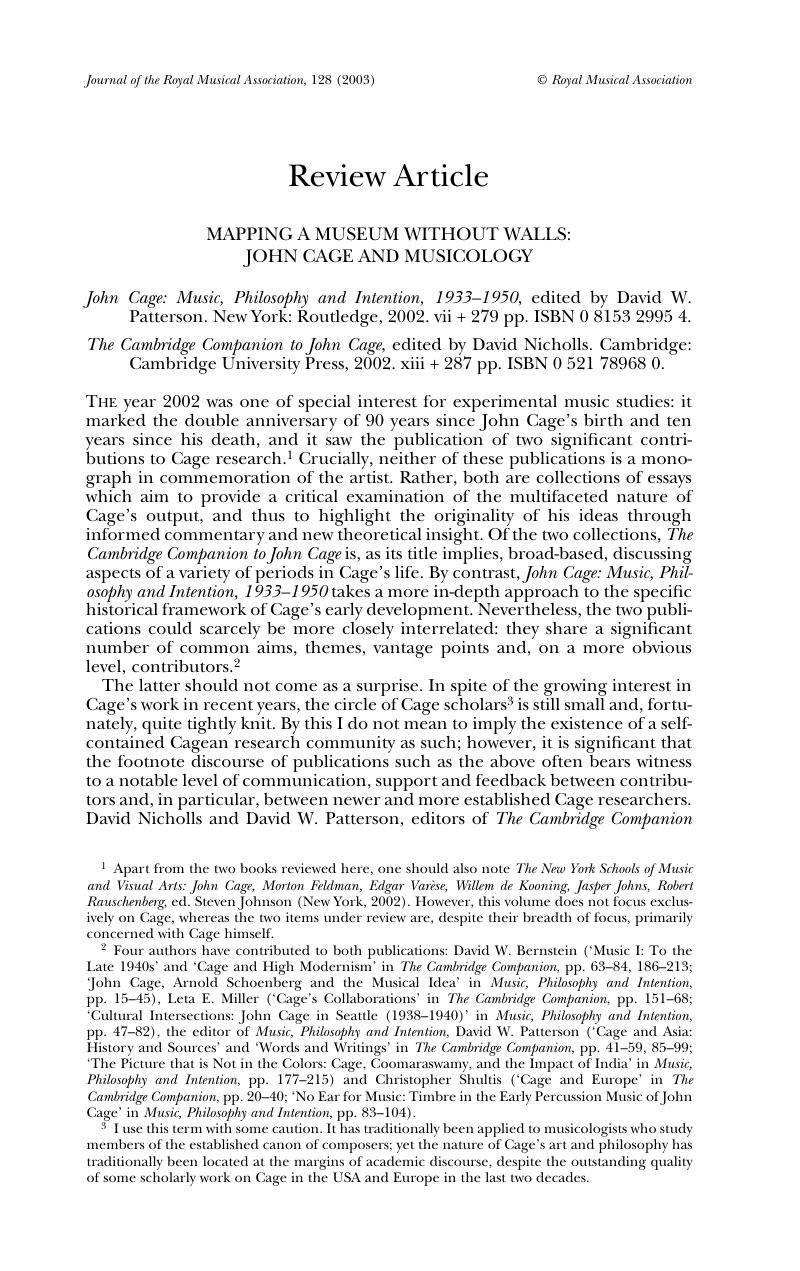No CrossRef data available.
Article contents
Mapping a Museum Without Walls: John Cage and Musicology - John Cage: Music, Philosophy and Intention, 1933–1950. edited by David W. Patterson, New York: Routledge, 2002. vii + 279 pp. ISBN 0 8153 2995 4. - The Cambridge Companion to John Cage, edited by David Nicholls. Cambridge: Cambridge University Press, 2002. xiii + 287 pp. ISBN 0 521 78968 0.
Published online by Cambridge University Press: 01 January 2020
Abstract

- Type
- Book Review
- Information
- Copyright
- Copyright © Royal Musical Association, 2003
References
1 Apart from the two books reviewed here, one should also note The New York Schools of Music and Visual Arts: John Cage, Morton Feldman, Edgar Varese, Willem de Kooning, Jasper Johns, Robert Rauschenberg, ed. Steven Johnson (New York, 2002). However, this volume does not focus exclusively on Cage, whereas the two items under review are, despite their breadth of focus, primarily concerned with Cage himself.Google Scholar
2 Four authors have contributed to both publications: David W. Bernstein (‘Music I: To the Late 1940s’ and ‘Cage and High Modernism’ in The Cambridge Companion, pp. 63–84, 186–213; ‘John Cage, Arnold Schoenberg and the Musical Idea’ in Music, Philosophy and Intention, pp. 15–45), Leta E. Miller (‘Cage's Collaborations’ in The Cambridge Companion, pp. 151–68; ‘Cultural Intersections: John Cage in Seattle (1938-1940)’ in Music, Philosophy and Intention, pp. 47–82), the editor of Music, Philosophy and Intention, David W. Patterson ('Cage and Asia: History and Sources’ and ‘Words and Writings’ in The Cambridge Companion, pp. 41–59, 85–99; ‘The Picture that is Not in the Colors: Cage, Coomaraswamy, and the Impact of India’ in Music, Philosophy and Intention, pp. 177–215) and Christopher Shultis (‘Cage and Europe’ in The Cambridge Companion, pp. 20–40; ‘No Ear for Music: Timbre in the Early Percussion Music of John Cage’ in Music, Philosophy and Intention, pp. 83–104).Google Scholar
3 I use this term with some caution. It has traditionally been applied to musicologists who study members of the established canon of composers; yet the nature of Cage's art and philosophy has traditionally been located at the margins of academic discourse, despite the outstanding quality of some scholarly work on Cage in the USA and Europe in the last two decades.Google Scholar
4 Key publications and writings by the above authors include David Nicholls, American Experimental Music: 1890–1940 (Cambridge, 1990); David W. Patterson, ‘Appraising the Catchwords, c.1942–1959: John Cage's Asian Derived Rhetoric and the Historical Reference of Black Mountain College’ (Ph.D. dissertation, Columbia University, 1996); Writings through John Cage's Music, Poetry and Art, ed. David W. Bernstein and Christopher Hatch (Chicago, 2001); Christopher Shultis, Silencing the Sounded Self: John Cage and the American Experimental Tradition (Boston, MA, 1998); William Brooks, ‘Choice and Change in Cage's Recent Music’, A John Cage Reader in Celebration of his 70th Birthday, ed. Peter Gena and Jonathan Brent (New York, 1982), 82–100; Alastair Williams, New Music and the Claims of Modernity (Aldershot, 1997).Google Scholar
5 See Stefanou, Danae, review of The Cambridge Companion to John Cage, Frankfurter Zeitschrift für Musikwissenschaft, 6 (2003), 46–52 (<www.8ung.at/fzmw/indexeng.htm>). Part of that review is reproduced here by kind permission of the editor.).+Part+of+that+review+is+reproduced+here+by+kind+permission+of+the+editor.>Google Scholar
6 Hamm illustrates this with reference to the work of James Pritchett (see Pritchett's The Music of John Cage, Cambridge, 1993) and David Patterson (particularly his doctoral dissertation, ‘Appraising the Catchwords‘). The former is an example of meticulous analysis of compositional techniques and their applications in various stages of Cage's output, whereas the latter comprises an equally scrupulous examination and interpretation of primary sources and documentary evidence of Cage's relation to Asian philosophies.Google Scholar
7 See Hicks, Michael, ‘John Cage's Studies with Schoenberg’, American Music, 2 (summer 1990), 125–40, and Robert Stevenson, ‘John Cage on his Seventieth Birthday’, Inter-American Music Review, 5 (1982), 3–17.Google Scholar
8 Bernstein takes this from The Musical Idea. See Schoenberg, Arnold, The Musical Idea and the Logic, Technique, and Art of its Presentation, trans. Patricia Carpenter and Severine Neff (New York, 1995), 21.Google Scholar
9 Miller's proposed date for the lecture is February 1940. She thus suggests that it was ‘a culmination, rather than a precursor’ of the compositions which marked Cage's experiences in Seattle, ‘its ideas honed from Cage's interactions with the Seattle artistic community, and reflecting influences both within and outside of music’ (p. 56).Google Scholar
10 John Cage, ‘Diary: How to Improve the World (You will only Make Matters Worse) Continued 1967‘, A Year from Monday (London, 1976), 151.Google Scholar
11 Cage, ‘Diary: How to Improve the World (You will only Make Matters Worse) 1965‘, A Year from Monday, 4.Google Scholar
12 John Cage, For the Birds: In Conversation with Daniel Charles (London, 1981), quoted in Miller, ‘Cage's Collaborations’, 168.Google Scholar
13 See, for instance, Part I of the Cambridge Companion, with reference to Cage's relation to America, Europe and Asia, in relation to some of the essays in Part III, particularly Miller's ‘Cage's Collaborations’ and Williams's ‘Cage and Postmodernism’. In Music, Philosophy and Intention see Miller's ‘Cultural Intersections’ in relation to Key's ‘John Cage's Imaginary Landscape No. 1’, Joseph's ‘“A Therapeutic Value for City Dwellers”’ and Patterson's ‘The Picture that is Not in the Colors'. It is equally interesting to observe the connecting threads across the two books: there is a marked similarity between Williams's and Joseph's essays, for instance, in that both tackle the different facets of the urban environment in relation to Cage's output.Google Scholar




